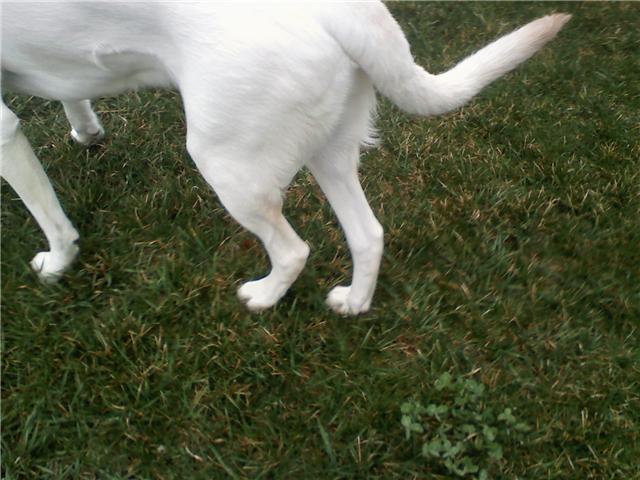
Hip problems can come from a variety of sources ranging from a sudden injury to old age. They will be apparent to you in the dogs movement and not often through clear vocal signs of pain.

How to Support Hip and Joint Health at Home.
How to tell if a lab has hip dysplasia. Other common Lab joint problems include osteoarthritis from old age and not necessarily hip dysplasia and elbow dysplasia which can result in lameness of the front legs. Always consult your veterinarian if you see the symptoms of Labrador hip dysplasia. X-rays and a full exam are necessary for proper diagnosis.
How Do You Know If Your Lab Has Hip Dysplasia. The easiest way to tell if you pup has CHD is to do an x-ray of their hips while they are sedated. This allows the veterinarian to see if the joint fits together as it should.
Many dogs dont show signs of CHD early in the disease and an x-ray is the only way to spot it. Unsurprisingly x-rays are the best way to discover Labrador Hip Dysplasia in a dog but with the disease being largely inherited hip scoring tests should also be carried out. Certainly when you are looking to purchase a Labrador puppy you must insist on seeing the hip scores of both parents.
Dog hip dysplasia symptoms do not normally include crying or whining with pain. They will be apparent to you in the dogs movement and not often through clear vocal signs of pain. Hip dysplasia diagnosis can only be made by a qualified veterinarian.
Your vet will physically examine your dog to see signs of hip dysplasia. Most of the estimates of heritability of hip dysplasia score in dogs are in the range of 02-03 which means that 20-30 of the variation you see among dogs in hip scores is accounted for by genetics - and it also means that 70-80 of the variation is from environmental causes many of which breeders and owners can control. If your dog is experiencing low-grade hip pain subtle signs like your dogs posture and the shape of their back may be one way to detect hip dysplasia.
If your dog suffers from hip dysplasia. Hip dysplasia is one of the most common skeletal disorders seen in dogs. The condition is characterized by a malformation of the coxofemoral hip joint.
Instead of the normal tight fit between the acetabulum cup or socket and femoral head ball patients with this condition suffer from a. Testing for hip dysplasia The test required to identify a predisposition to hip dysplasia is called hip scoring and ultimately results in the person assessing the state of a given dogs hips assigning a score to them which indicates how healthy or otherwise they are. If theres an unexplained limping waddling or unsteady trot in puppies it could be hip dysplasia rearing its ugly head.
You may spot occasional or persistent limping depending on how severe the disorder is. Reluctance to Jump or Climb Stairs The ability to jump is inherent in our furry pals. In severe cases of hip dysplasia there are some visible signs that can be alarming.
The hip will look unnatural or in some cases the joints look enlarged due to the inflammation of the joint. A vet will also be able to take an X-ray of a joint to tell if your dog has hip dysplasia. Signs of Hip Dysplasia Some cases of hip dysplasia are so mild that there are no signs but if it looks like your dog is stiff when getting up if he doesnt want to exercise stand on his hind legs or climb stairs or if he is bunny-hopping or limping a visit to the veterinarian is mandatory.
Hip dysplasia is a complex inherited condition where the hip joint does not develop correctly. As a dog gets older the joint undergoes wear and tear and deteriorates leading to a loss of function. This can cause varying degrees of pain discomfort stiffness and lameness.
How is hip dysplasia. A pup that has hip dysplasia will be more inclined to lie down for longer and may act like it doesnt want to get up after it has rested. This is because its hips become stiff when resting after activity.
See if your pup or young dog is hesitant to jump up on things. If your pup has hip dysplasia. Hip dysplasia will get worse with age and older dogs will often start to struggle with their mobility.
This can include being unable to climb stairs jump onto or off a couch or run like they once did. This level of hip dysplasia can be managed though with adjustments in lifestyle as your dog gets older. Hip dysplasia is the abnormal development dysplasia of a dogs hip joints.
Genes are a major factor to developing this condition so dogs can inherit hip iss. How can I tell if my Lab has hip dysplasia. If your Lab is just a puppy you probably wont see any signs of hip dys-plasia even if she has it.
Thats because the arthritis associated with hip dysplasia takes a while to develop so the lameness most. Common Signs of Hip Problems in Dogs. How to Know for Sure if Your Dog Has Hip Problems.
How to Support Hip and Joint Health at Home. Hip problems can come from a variety of sources ranging from a sudden injury to old age. For longer-term or more serious problems always work with your vet to develop a treatment plan for your pup.
Find a responsible breeder that does the appropriate health screenings such as radiographs for hip dysplasia and more. The best way that breeders can prevent hereditary hip dysplasia is to screen.